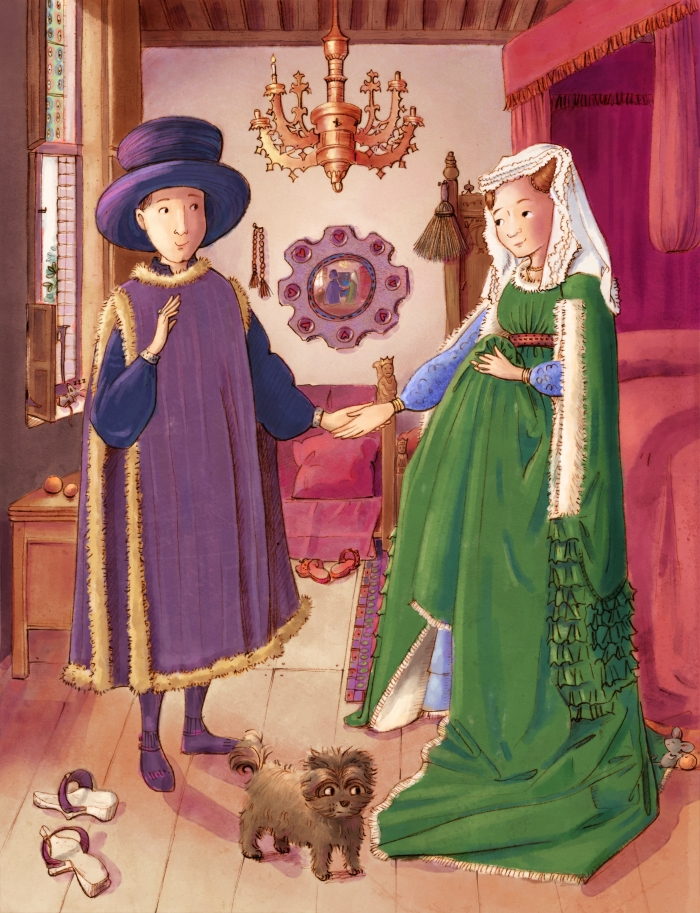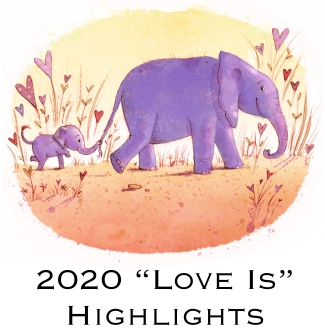

My Changes:
I opted to keep the general color palette after playing around with changing various elements (her dress, the walls, his cloak), but decided to brighten what was already there. Van Eyck’s original painting is quite dark, but some of that darkness may not only be be the result of personal/client preference but also of aging and whatever paints were accessible to Van Eyck at the time. I tried changing her dress color, but then learned that green cloth at the time was an indication of wealth and I felt I needed to keep it green to preserve one message of the painting.
In the original, Van Eyck masterfully guides our eye to what he wants us to care about with his use of value, but I wanted to create an airier, more modern feel to the room by lightening things up. I especially wanted to make sure you could see the dog (something my son hadn’t seen until my version)—hence the massively lightened flooring. I also chose to simplify many of the doodads: the chandelier, mirror, carvings, rug, ruffles, stained glass. I also love my characters to have personality and turned the Arnolfini’s gaze to look at each other . . .
Things I thought/Questions I asked:
I remember loving this painting as a child, impressed by the realism, the many fabric folds, and gleaming chandelier. To see things even better, I lightened up the original and my eyes were opened! Each time I noticed a new detail, I was in awe by the extravagant wealth of this couple. I had never noticed the intricate carvings on the bedstand and chair, the stain glass window, their rings, the myriad fabric types (velvet, fur, silk, embroidery, etc), the broom, the shoes. Speaking of which, his wooden shoes look quite unique while I was surprised that hers—by the chair—look like something women might wear today.
Although my chandelier isn’t quite as intricate as the original, I hope you appreciate my attempt to maintain some semblance of similarity!
I couldn’t help doing a little research about this painting and discovered that oranges were quite rare and expensive at the time (yet another symbol of their wealth), and that Arnolfini was a cloth merchant—made especially evident by the various fabrics throughout.
I wondered about what life was like for the Arnolfini’s. Although they were apparently quite wealthy, they still lived in a small-by-today’s-standards room. I love the open window, along with the brief mention of a tree outside—meaning it was probably spring or summer.
I love that they have a dog. Did they play with it? Take it on walks?
What was family life like for the Arnolfinis? Did they talk at mealtimes? Go on walks after dinner? Was he often away on business? Did they have a happy marriage? (I learned that they never had children.) What did she do during the day? while he was away? How did they meet? Did they know each other as children, or was this an arranged marriage? What was it like to wear those klompen (wooden shoes) outside? Did they actually sit on that chair, or was it simply another symbol of wealth? What did they put inside of the dresser by the window? The draperies hanging from the canopy are quite unique. Is anything inside of them? Did the floors squeak?
What I noticed or learned from Van Eyck’s techniques:
Van Eyck was a master of detail! Each time I look, there’s something new to find, and Van Eyck cared about making all of it look amazing. I’m impressed he painted all ten mini-paintings within the mirror (and that he drew an additional painting of the reverse of the room in that mirror)! He also knew how to paint each texture so it looked real, whether wood, metal, cloth, hair. I admit I had to slow way down so that I could draw the various fabrics and objects—not always my favorite thing to do!
Van Eyck also fully understood composition and value—there’s no question what to look at first.
I also love his signature on the wall and actually made my own with a semblance of his flair, but since it looked burry in this smaller version I omitted it for this blog. (I also chose not to include myself in the painting!)

My Changes:
Cropped it and rearranged the composition so the focus is more on the boys and birds (I’ll call them ducks). Made the tree bigger. Made the boys a little younger, added some expression, changed the pose of the boy (or girl—you decide!) feeding ducks. Brightened colors a bit. Gave colors a little more dimension, added patterns to the kimonos.
Things I thought/Questions I asked:
This painting is really, really old! It’s amazing it’s lasted 500-600 years!
Who are these boys? Do they go to school? Have they left school (or work) to feed the ducks, or are they out on an excused break? Are they brothers? friends? What time of year/day is this? Is it cold? The boy on the left has his hands in his sleeves, which makes me think he is. (I’m often cold and pick up on these clues!) Their kimonos also look a little thick. I wonder what they are made out of. Those belts are interesting. Are they strips bound together and tied around their waists? Their shoes look a little bit like klompen (Dutch wooden shoes). Or are they made from fabric? Are they comfortable?
Why isn’t the boy on the left feeding the ducks? Does he want to be there, or would he rather be somewhere else? What is the boy on the right feeding the ducks? When did the tradition of feeding ducks start, anyway?
Do these boys visit this place often? What does it sound like?
The boys’ hair looks like it’s shaved everywhere except for where their pigtails are. Are these boys wealthy or poor? Do they laugh much? Where is their family? Are they standing on a rock or on grass? I think it’s a rock?
What I noticed or learned from Shen Zhou’s techniques:
While applying some of his descriptions into my take on this piece, my guess is that landscapes were what he loved most. He spends a lot of time on crevices and leaves (way more time than me!), and much less on people. I like the way he painted the leaves on the tree by the boys. I also enjoy his linework, particularly in the way he drew the birds.
I wish I could ask Zhou why he decided to paint this picture. Did he know these boys? Did he just see them and decide to paint them?

When I was little, Mom and I often looked through a beautiful book of Masterpieces. I asked lots of questions about these people painted in time: How were we the same? How were we different? If you are also a fan of masterpieces, children’s book art, and searching for mice, I invite you to follow along!
All original images © Angela C. Hawkins


Love a MousterWork print? They will be available in my Etsy shop. Don’t see the one you want? Email me and I’ll add it in.